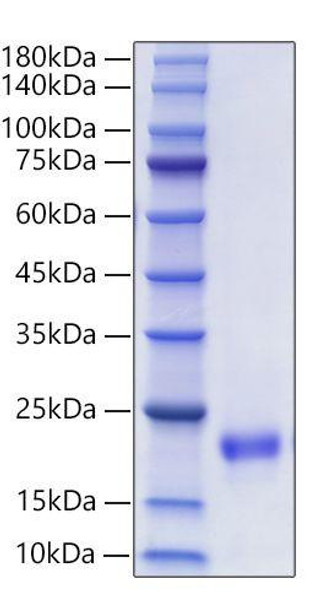Description
Recombinant Mouse VEGF-D/FIGF Protein
The Recombinant Mouse VEGF-D/FIGF Protein is a high-quality recombinant protein designed for murine biological research applications. This protein serves as an essential reagent in mouse model studies, comparative immunology research, and preclinical therapeutic evaluations, enabling scientists to investigate VEGF-D/FIGF biology and its relevance to human disease mechanisms through translational research approaches.
This product (SKU: RPCB1252) is produced using HEK293 cells and features a C-6*His tag for convenient detection and purification. The protein exhibits a calculated molecular weight of 12.85 kDa with an observed molecular weight of 20-25 kDa under denaturing conditions, achieving ≥ 90% as determined by SDS-PAGE.. Functional bioactivity has been validated through rigorous quality control assays, confirming its suitability for demanding research applications.
Key Features
| High Purity by Affinity Chromatography | |
| Mammalian & Bacterial Expression Systems | |
| High lot-to-lot consistency via strict QC |
| Product Name: | Recombinant Mouse VEGF-D/FIGF Protein |
| SKU: | RPCB1252 |
| Size: | 10 μg , 20 μg , 50 μg , 100 μg |
| Reactivity: | Mouse |
| Synonyms: | Vegfd, Figf, Vascular endothelial growth factor D, VEGF-D, c-Fos-induced growth factor, FIGF |
| Tag: | C-6*His |
| Expression Host: | HEK293 cells |
| Calculated MW: | 12.85 kDa |
| Observed MW: | 20-25 kDa |
| Gene ID: | 14205 |
| Protein Description: | High quality, high purity and low endotoxin recombinant Recombinant Mouse VEGF-D/FIGF Protein (RPCB1252), tested reactivity in HEK293 cells and has been validated in SDS-PAGE.100% guaranteed. |
| Endotoxin: | < 0.1 EU/μg of the protein by LAL method. |
| Purity: | ≥ 90% as determined by SDS-PAGE. |
| Formulation: | Lyophilized from 0.22 μm filtered solution in PBS (pH 7.4). Normally 8% trehalose is added as protectant before lyophilization. |
| Bio-Activity: | Measured by its binding ability in a functional ELISA. Immobilized Mouse VEGFD(RPCB1252) at 5 μg/mL (100 μL/well) can bind Human VEGFR-3/FLT-4 (RPCB0299) with a linear range of 0.5-67.73 ng/mL. |
| Reconstitution: | Centrifuge the vial before opening. Reconstitute to a concentration of 0.1-0.5 mg/mL in sterile distilled water. Avoid vortex or vigorously pipetting the protein. For long term storage, it is recommended to add a carrier protein or stablizer (e.g. 0.1% BSA, 5% HSA, 10% FBS or 5% Trehalose), and aliquot the reconstituted protein solution to minimize free-thaw cycles. |
| Storage: | Store at -20℃.Store the lyophilized protein at -20℃ to -80 ℃ up to 1 year from the date of receipt. After reconstitution, the protein solution is stable at -20℃ for 3 months, at 2-8℃ for up to 1 week. |
Vascular endothelia growth factor D (VEGF-D), also known as c-fos-induced growth factor (FIGF), is a secreted glycoprotein of the VEGF/PDGF family. VEGFs regulate angiogenesis and lymphangiogenesis during development and tumor growth, and are characterized by eight conserved cysteine residues that form a cysteine-knot structure. VEGF-C and VEGF-D, which share 23% amino acid (aa) sequence identity, are uniquely expressed as preproproteins that contain long N- and C-terminal propeptide extensions around the VEGF homology domain (VHD). Proteolytic processing of either 358 aa or 326 aa splice forms of mouse VEGF-D preproprotein creates a secreted proprotein. Further processing by extracellular serine proteases, such as plasmin or furin-like proprotein convertases, forms mature VEGF-D consisting of non-covalently linked 42 kDa homodimers of the 117 aa VHD. Mature mouse VEGF-D shares 94%, 99%, 93%, 91% and 89% aa identity with the VHD of human, rat, equine, canine and bovine VEGF-D, respectively. It is expressed in adult lung, heart, muscle, and small intestine, and is most abundantly expressed in fetal lungs and skin. Mouse and human VEGF-D are ligands for VEGF receptor 3 (VEGF-R3, also called Flt-4) that are active across species and show enhanced affinity when processed. Unlike human VEGF-D, which is also a ligand for VEGF-R2 (also called Flk-1 or KDR), mouse VEGF-D does not bind to VEGF-R2. VEGF-R3 is strongly expressed in lymphatic endothelial cells and is essential for regulation of the growth and differentiation of lymphatic endothelium. While VEGF-C is the critical ligand for VEGF-R3 during embryonic lymphatic development, VEGF-D is most active in neonatal lymphatic maturation and bone growth. Both promote tumor lymphangiogenesis. Consonant with their activity on VEGF receptors, binding of VEGF-C and VEGF-D to neuropilins contributes to VEGF-R3 signaling in lymphangiogenesis, while binding to integrin alpha 9 beta 1 mediates endothelial cell adhesion and migration.








